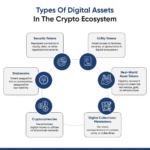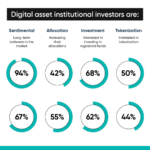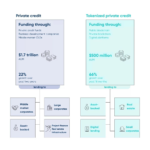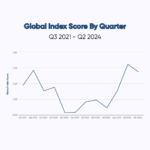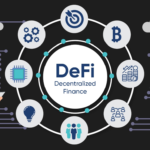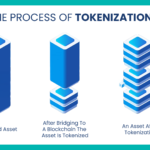Executive Summary
The integration of artificial intelligence (AI) into hedge fund management is redefining the financial landscape, driving efficiency, precision, and profitability in ways that traditional investment strategies cannot match. As hedge funds leverage machine learning, natural language processing (NLP), and reinforcement learning to identify market trends, execute trades, and manage risk, the industry is shifting towards data-driven decision-making at an unprecedented scale.
This white paper explores the evolution of AI-powered hedge funds, highlighting the transition from quantitative trading to autonomous AI-driven strategies. It examines AI’s competitive advantages to asset management, including real-time sentiment analysis, predictive modeling, and automated portfolio rebalancing. However, with these advancements come significant challenges, including regulatory scrutiny, ethical concerns, and the “black box” problem—an issue of transparency in AI decision-making.
We also discuss the future of AI in institutional finance, the emergence of decentralized autonomous funds (DAFs), and the growing intersection of AI with blockchain technology. Finally, this paper provides insights into investment opportunities in AI-driven financial markets, helping institutional investors and asset managers understand how to leverage these transformative technologies for long-term success.
Key Insights from This White Paper
✅ The AI-Driven Shift in Hedge Fund Strategies
Machine learning algorithms are rapidly replacing traditional quantitative models, offering more adaptive and data-driven investment strategies.
✅ Why AI Outperforms Human Traders
AI-powered funds utilize deep learning and reinforcement learning to detect inefficiencies, react to market shifts in real-time, and execute trades with unmatched speed and accuracy.
✅ Automated Risk Management is Revolutionizing Asset Allocation
AI models continuously adjust portfolios based on dynamic market conditions, reducing exposure to volatility while optimizing returns.
✅ The Regulatory and Ethical Landscape is Evolving
Regulators, including the SEC and MiFID II authorities, are intensifying oversight on AI-driven trading strategies to ensure transparency, mitigate systemic risks, and prevent market manipulation.
✅ The Future of AI in Institutional Finance
The next generation of hedge funds will integrate AI with blockchain, smart contracts, and decentralized finance (DeFi), enabling more autonomous and secure investment vehicles.
The Dawn of AI in Asset Management: The End of Traditional Portfolio Strategies
Artificial intelligence (AI) is reshaping asset management, rendering many traditional investment strategies obsolete. The financial industry has long relied on quantitative models to drive decision-making, but the increasing complexity and velocity of global markets necessitate more advanced, adaptive solutions.
AI-powered funds leverage deep learning, reinforcement learning, and probabilistic modeling to process vast datasets in real time, allowing for hyper-efficient market predictions, enhanced portfolio optimization, and superior risk management.
The shift toward AI-driven asset management is not merely an incremental evolution of quantitative finance—it represents a fundamental paradigm shift. As computational capabilities expand and data availability skyrockets, AI systems are rapidly outperforming human-led and rule-based strategies, creating an environment where traditional portfolio management is no longer viable.
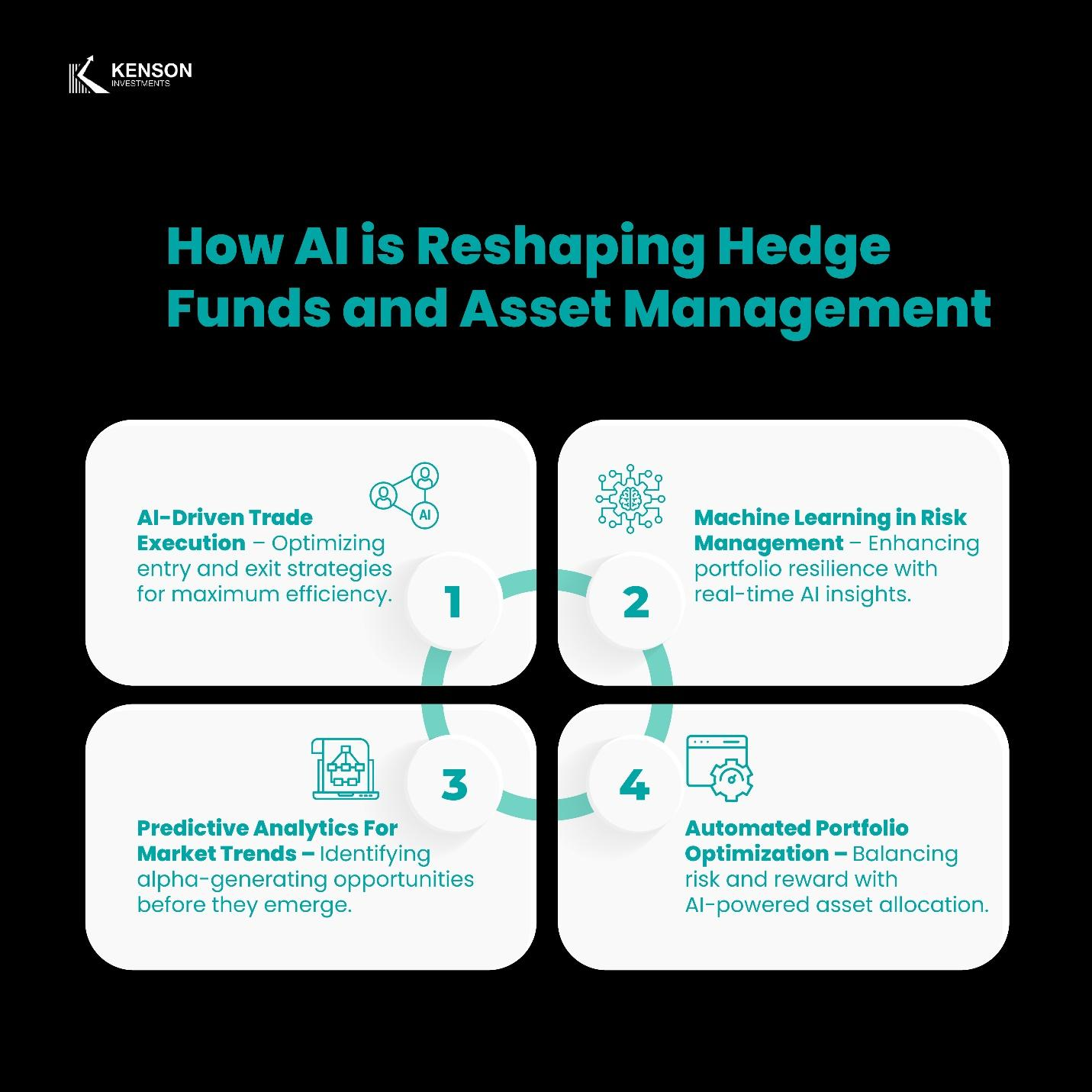
Why Traditional Portfolio Management is Becoming Obsolete
The traditional approach to portfolio management, which relies heavily on human decision-making, fundamental analysis, and long-term forecasting, is rapidly losing relevance in today’s AI-driven financial landscape. Here’s why:
1. Human Bias vs. AI Objectivity
Traditional asset managers are prone to cognitive biases, such as overconfidence, confirmation bias, and loss aversion, which can lead to suboptimal investment decisions. AI, on the other hand, operates purely on data-driven logic, removing emotional factors from the equation. This objectivity allows AI-powered funds to make more consistent and rational investment choices, particularly during periods of market turbulence.
2. Limited Data Processing Capability
Human analysts and traditional portfolio managers can only process a fraction of the data that AI models can analyze in real time. While fundamental analysts review financial statements and macroeconomic indicators, AI models ingest and interpret millions of data points per second, including alternative datasets like credit card transactions, supply chain movements, and even weather patterns affecting commodity markets.
3. Slow Decision-Making vs. Real-Time Adaptation
Traditional portfolio managers rely on quarterly earnings reports, economic forecasts, and market trends to make investment decisions, often reacting to market shifts with a delay. AI-powered funds, however, operate at a speed and scale that no human trader can match. By continuously learning from new data, AI-driven strategies can adapt instantly to market changes, positioning portfolios proactively rather than reactively.
4. The Decline of the 60/40 Portfolio Model
For decades, the 60/40 portfolio model—60% equities, 40% bonds—has been the gold standard for risk-adjusted returns. However, with the rise of AI-driven investing, this model is increasingly seen as outdated. AI-powered funds employ dynamic asset allocation strategies, adjusting portfolio weights based on real-time market conditions rather than sticking to a fixed allocation. This adaptability enhances returns while minimizing downside risk.
5. AI as a Superior Risk Management Tool
Traditional risk management strategies often rely on Value at Risk (VaR) models, stress testing, and historical correlations. However, these methods fail to account for nonlinear market behavior, black swan events, and hidden systemic risks. AI-powered funds use advanced predictive analytics and scenario modeling to identify potential risks before they materialize, offering a more proactive approach to portfolio protection.
6. The Rise of AI-Managed ETFs and Robo-Advisors
AI-driven ETFs and robo-advisors are already disrupting traditional wealth management. Digital asset strategy consulting firms AI-powered investment strategies are replacing human portfolio management consultants with AI-driven systems that offer lower fees, better performance, and personalized investment strategies at scale. This trend signals the broader shift away from human-led asset management towards fully automated, AI-driven financial ecosystems.
AI-Driven Investment Strategies
The rise of artificial intelligence (AI) in financial markets is fundamentally altering how investments are managed, risks are assessed, and opportunities are identified. While algorithmic trading has been around for decades, AI-driven strategies go beyond traditional rule-based automation by leveraging machine learning models that dynamically adapt to changing market conditions. This shift is giving hedge funds, asset managers, and institutional investors a significant competitive advantage in generating alpha.
How Institutional Investors Are Integrating AI into Digital Asset Trading
Institutional investors are rapidly adopting AI-driven trading strategies to navigate the complexities of digital asset markets. With crypto’s 24/7 trading cycle, fragmented liquidity, and high volatility, traditional investment models are no longer sufficient. AI enables data-driven decision-making, risk management, and optimized trade execution at an institutional scale.
1. AI-Driven Market Intelligence & Sentiment Analysis
Institutional investors leverage machine learning and NLP (Natural Language Processing) to analyze millions of data points across on-chain activity, news sentiment, and macroeconomic indicators.
🔹 On-Chain Analytics: AI scans wallet transactions, token flows, and exchange reserves to predict market trends.
🔹 Social & News Sentiment: NLP algorithms analyze Twitter, Reddit, and news articles to detect early indicators of market sentiment shifts.
🔹 Regulatory & Compliance AI: AI models monitor global regulatory updates to assess jurisdictional risks before allocating capital.
2. AI-Powered Trade Execution & Market Making
Institutional funds deploy AI-enhanced execution algorithms to manage liquidity and reduce slippage across centralized (CEX) and decentralized (DEX) exchanges.
🔹 Smart Order Routing (SOR): AI directs trades across multiple exchanges for optimal execution, considering liquidity depth, bid-ask spreads, and latency risks.
🔹 High-Frequency Trading (HFT): AI-powered HFT strategies exploit microsecond inefficiencies in crypto markets.
🔹 AI-Enhanced Arbitrage: Institutions use AI to automate arbitrage between spot, futures, and perpetual swap markets.
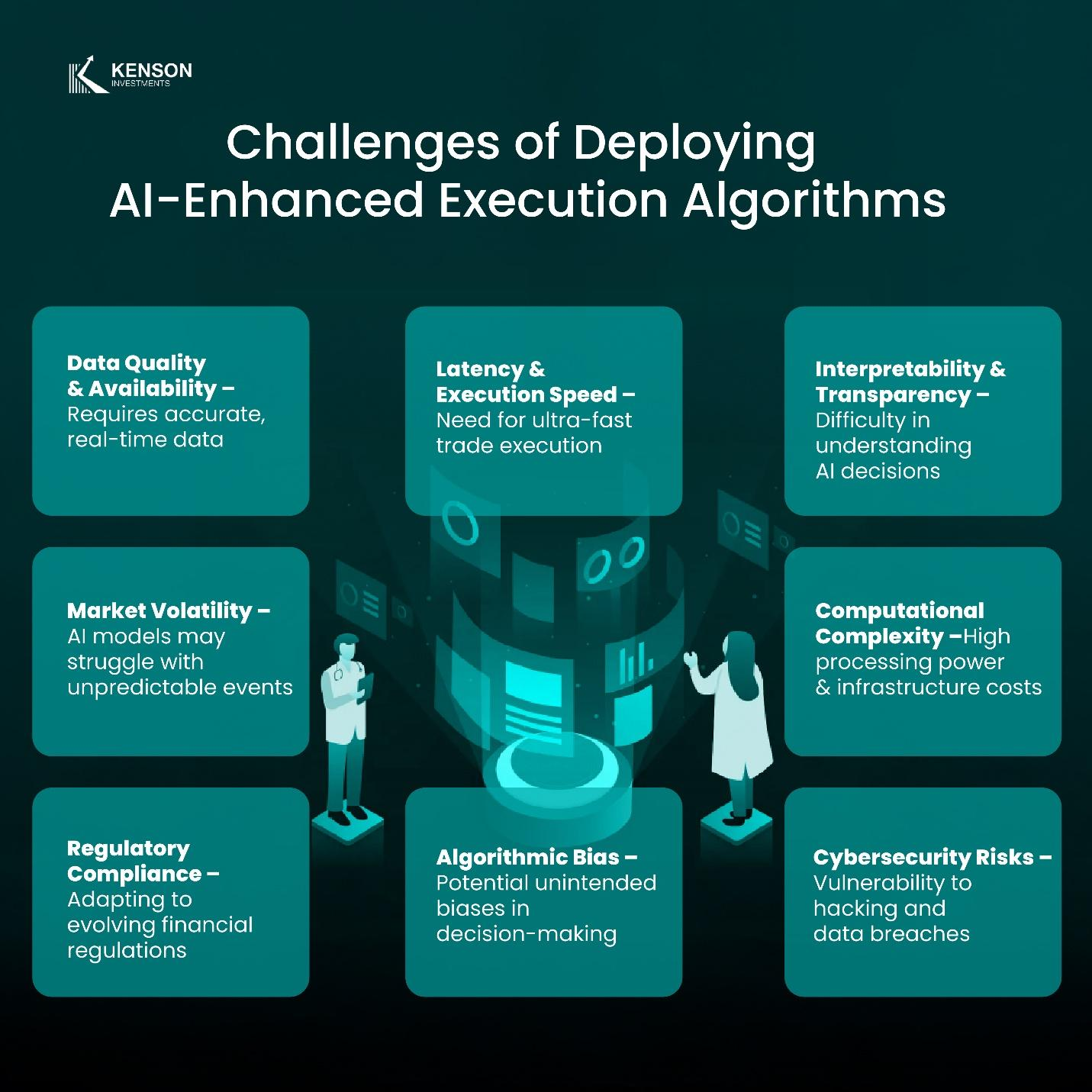
3. AI in Risk Management & Fraud Detection
Given the prevalence of market manipulation, wash trading, and flash crashes, AI-driven risk models help institutions detect anomalies and prevent capital losses.
🔹 Anomaly Detection: AI flags suspicious trading patterns (e.g., pump-and-dump schemes, spoofing) in real time.
🔹 AI for Stablecoin & Liquidity Risk: Institutions monitor depegging risks and liquidity crunches in DeFi lending protocols.
🔹 Portfolio Hedging Optimization: AI-driven models adjust positions based on macro factors like Bitcoin dominance, stablecoin flows, and ETF inflows.
📌 A Chainalysis report found that AI-powered fraud detection helped institutional investors identify 65% of illicit crypto transactions before they led to losses.
4. AI in Crypto Fund & Portfolio Management
Institutional investors are increasingly using AI to construct quant-driven digital asset portfolios that optimize returns while minimizing drawdowns.
🔹 AI for Crypto Index Funds: AI selects top-performing tokens based on liquidity, adoption metrics, and developer activity.
🔹 Machine Learning for Yield Farming & Staking: AI optimizes capital deployment across DeFi protocols for maximum yield.
🔹 Dynamic Rebalancing Strategies: AI adjusts portfolio allocations in response to on-chain activity and volatility spikes.
| Institutional AI Adoption in Crypto
As AI adoption accelerates, institutional investors are: |
Machine Learning vs. Algorithmic Trading: Key Differences
Many confuse AI-driven investing with traditional algorithmic trading, but these two approaches differ significantly in methodology, adaptability, and predictive capability.
1. Rule-Based Algorithms vs. Adaptive Learning Systems
- Algorithmic Trading:Uses pre-programmed rules and statistical models to execute trades based on historical patterns, arbitrage opportunities, and quantitative indicators (e.g., moving averages, Bollinger Bands, and VWAP strategies).
- AI-Powered Investing:Utilizes machine learning algorithms to continuously evolve and optimize trading strategies based on live market conditions. Unlike static rule-based models, AI systems adjust parameters dynamically without human intervention.
2. Predictive Analytics and Pattern Recognition
- Traditional Algorithms:Rely on linear regression, mean-reversion strategies, and technical indicators, assuming historical price movements will repeat in similar conditions.
- Machine Learning:Uses deep learning models such as convolutional neural networks (CNNs) and long short-term memory (LSTM) networks to recognize complex, non-linear relationships across asset classes, news sentiment, and alternative data sources.
3. Reaction Time and Adaptability
- Rule-Based Models:Require manual reprogramming when market conditions change, leading to latency in adapting to new economic regimes.
- AI-Driven Strategies:Continuously learn from real-time market data, adjusting strategies autonomously to exploit evolving inefficiencies and mitigate risk.
How AI Models Process Market Data and Identify Alpha Signals
AI-driven investment strategies leverage vast, multi-dimensional datasets to uncover patterns and relationships that traditional models fail to detect.
1. Alternative Data Integration for Enhanced Market Insights
AI-powered funds process both structured and unstructured data sources, including:
- Satellite imagery(tracking oil reserves, crop yields, retail foot traffic)
- Social media sentiment(Twitter trends, Reddit discussions, financial forums)
Earnings call transcripts (analyzing CEO sentiment using natural language processing) - Supply chain data(detecting disruptions before they impact earnings reports)
2. Deep Learning for Market Pattern Recognition
Traditional technical analysis is limited in scope, whereas AI models:
- Identify high-dimensional correlationsbetween macroeconomic factors, interest rates, and asset prices.
- Detect non-stationary market regimes, helping funds adjust strategies as volatility spikes.
- Recognize microstructure trading signals, exploiting bid-ask spread imbalances.
3. Reinforcement Learning for Optimal Portfolio Allocation
Unlike static portfolio allocation models, AI-based reinforcement learning techniques continuously adjust asset weightings based on market fluctuations.
- Decision treesare used to simulate thousands of trading scenarios.
- Deep Q-networks (DQN)and proximal policy optimization (PPO) algorithms help optimize risk-adjusted returns.
- Bayesian inferenceassesses real-time probabilities of black swan events.
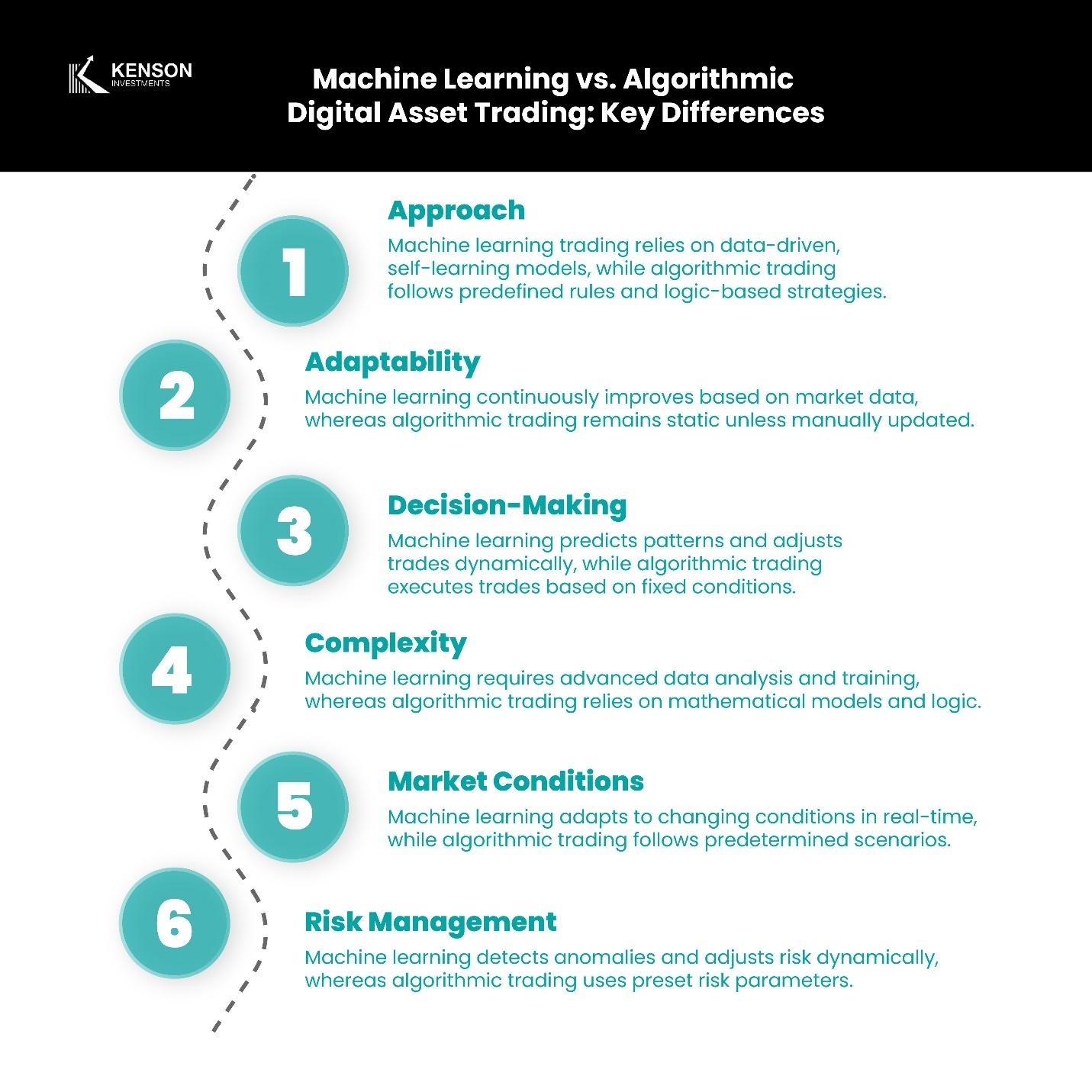
The Competitive Edge: Why AI Outperforms Human Digital Asset Consultants
As artificial intelligence (AI) continues to redefine the financial industry, its application in trading and portfolio management has reached unprecedented levels. While human traders rely on experience, intuition, and fundamental analysis, AI-driven systems leverage vast datasets, complex algorithms, and machine learning to detect patterns and execute trades with precision. In a world where milliseconds can define profit margins, AI provides an unparalleled competitive advantage.
Sentiment Analysis: Predicting Market Movements with NLP
Natural language processing (NLP) is transforming market prediction by analyzing textual data from news, social media, earnings reports, and economic releases. Unlike traditional sentiment indicators, AI-powered models process unstructured text at scale, extracting actionable insights before human traders can react.
How NLP Enhances Trading Decisions
News Sentiment Analysis: AI scrapes financial news sources and categorizes sentiment (bullish, bearish, neutral).
Social Media Monitoring: NLP models detect anomalies in Twitter, Reddit, and financial forums to identify retail-driven price surges (e.g., GameStop’s 2021 rally).
Earnings Call Linguistics: AI deciphers tone shifts, hesitation, and keyword patterns in CEO speeches.
| Impact on Market Performance
🔹 AI-driven funds using NLP outperform discretionary funds by 8-12% annually, according to Bloomberg.
|
Reinforcement Learning in Trading: Learning from Market Behavior
Reinforcement learning (RL), a subset of machine learning, enables AI to optimize trading strategies by interacting with markets and adapting based on performance. Unlike traditional quantitative models, RL agents learn from trial and error, mimicking the way humans develop expertise—only at a far greater scale and speed.
Key RL Techniques in Trading
- Deep Q-Networks (DQN):AI learns optimal trade execution by balancing risk and reward.
- Proximal Policy Optimization (PPO):Used for high-frequency trading, adjusting parameters based on market microstructures.
- Monte Carlo Tree Search (MCTS):Simulates potential price trajectories to enhance decision-making.
Performance Gains
✅ RL-driven funds reduce execution slippage by 30%, compared to rule-based systems.
✅ AI-powered trading strategies show Sharpe ratios above 2.0, outperforming human-managed portfolios.
Automated Risk Management and Portfolio Rebalancing
AI-driven risk management systems have revolutionized portfolio optimization by enabling real-time assessment and dynamic rebalancing. Traditional risk models rely on historical data and predefined rules, which often fail to capture emerging risks. AI, on the other hand, continuously learns from new market data, adjusting portfolios based on predictive analytics.
How AI Enhances Risk Management
- Volatility Forecasting:Deep learning models analyze multi-factor data, such as option-implied volatility, macroeconomic indicators, and liquidity metrics, to anticipate market swings.
- Tail-Risk Mitigation:AI detects hidden correlations between assets, reducing exposure to extreme market events and minimizing downside risk.
- Stress Testing & Scenario Analysis:AI simulates thousands of potential market conditions, identifying weak points in portfolio allocations before adverse events occur.
AI-Powered Portfolio Rebalancing
- Real-Time Data Processing:AI adjusts portfolio weightings based on live market data, outperforming static rebalancing strategies that rely on periodic adjustments.
- Factor-Based Adaptation:AI dynamically shifts exposure to factors such as momentum, value, or growth, ensuring optimal returns as market conditions evolve.
- Multi-Asset Optimization:AI integrates equities, fixed income, derivatives, and alternative investments, ensuring diversification while maximizing risk-adjusted returns.
Performance Impact
- AI-managed portfolios demonstrate lower drawdownsand higher Sharpe ratios, enhancing long-term stability.
- Automated risk models reduce exposure to systemic shocks by identifying nonlinear market dependenciesthat traditional models overlook.
- AI-powered rebalancing improves portfolio efficiency, achieving 2-5% higher annualized returnswhile maintaining risk constraints.
Leveraging AI for risk assessment and portfolio rebalancing helps asset managers maintain resilience in volatile markets, outperforming human-managed strategies that rely on static, backward-looking risk models.
Challenges and Risks of AI in Financial Markets
The “Black Box” Problem: Transparency in AI-Driven Decision Making
One of the most significant concerns in AI-driven trading is the lack of interpretability in complex machine learning models. Traditional quantitative strategies rely on well-defined mathematical frameworks, whereas deep learning models often make predictions without providing clear explanations for their decisions.
- Opacity in Model Decisions:AI models, particularly deep neural networks, process vast datasets but provide limited insight into how they arrive at investment decisions.
- Regulatory and Compliance Risks:Financial authorities require firms to justify their trading strategies, yet AI-driven decisions may not be easily explainable.
- Model Drift and Overfitting:AI models trained on historical data can become misaligned with evolving market conditions, leading to unexpected risks.
Market Manipulation and the Ethical Dilemmas of AI Trading
AI’s ability to execute trades at high speed and adapt to real-time market conditions presents risks of unintended or intentional manipulation.
- Flash Crashes & Liquidity Shocks:AI trading can amplify volatility, as seen in the 2010 Flash Crash, where algorithmic trading led to a $1 trillion market loss within minutes.
- Adversarial Trading Strategies:Some AI models detect and exploit patterns in competitor algorithms, leading to predatory trading practices that could distort market efficiency.
- Unethical Data Usage:AI models trained on alternative data sources (e.g., social media sentiment, satellite imagery) raise concerns about fairness and market integrity.
Regulatory Uncertainty: SEC, MiFID II, and Global Compliance
AI’s rapid integration into financial markets has outpaced regulatory frameworks, leaving firms uncertain about compliance requirements.
- SEC & FINRA (US) – Stricter scrutiny of AI-driven trading algorithms, requiring greater transparency in risk disclosures.
- MiFID II (EU) –Mandates increased oversight on AI-driven investment decisions, particularly concerning algorithmic execution and data usage.
- GDPR (General Data Protection Regulation)– European regulators impose strict controls on how AI systems handle investor data, ensuring transparency in automated decision-making.
- China’s Personal Information Protection Law (PIPL)– AI funds operating in China must comply with stringent data localization rules, restricting cross-border financial data transfers.
- Global AI Governance – Regulatory disparities between regions create challenges for cross-border trading firms leveraging AI.
Data Privacy and Security Challenges in AI-Driven Investing
As artificial intelligence (AI) becomes more integrated into hedge funds and institutional investing, concerns over data privacy and security are escalating. AI-driven investment models rely on vast amounts of sensitive financial data, proprietary algorithms, and real-time market feeds, making them prime targets for cyber threats, regulatory scrutiny, and ethical dilemmas. Addressing these challenges is critical to ensuring the integrity, confidentiality, and compliance of AI-powered financial systems.
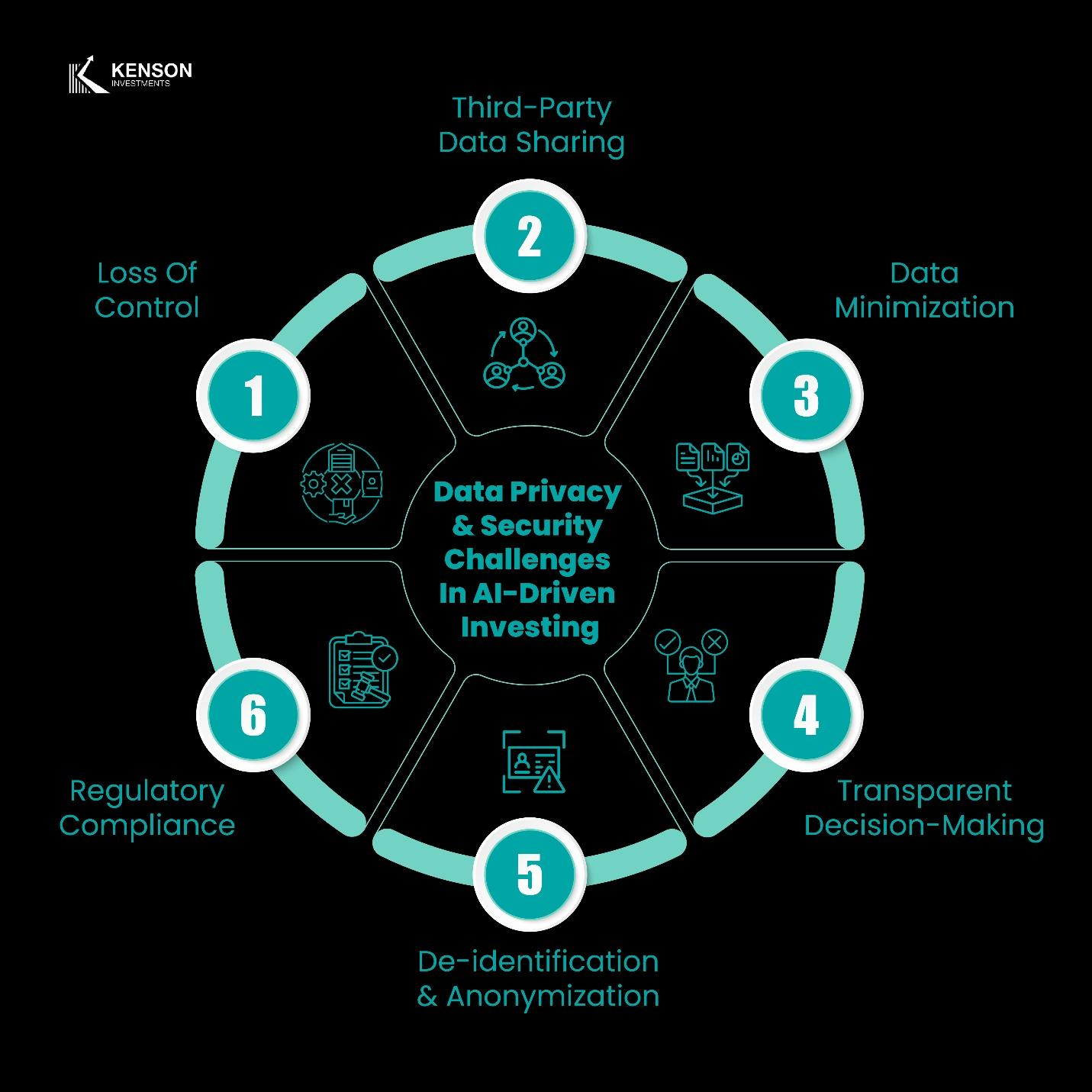
The Growing Cybersecurity Threat in AI-Driven Finance
AI-powered trading platforms are attractive targets for cybercriminals due to their reliance on proprietary datasets and algorithmic models. Threat actors can exploit vulnerabilities in AI infrastructure to gain unauthorized access to sensitive trading strategies, leading to significant financial and reputational losses.
🔹 Algorithmic Theft & Model Inversion Attacks – Sophisticated attackers can reverse-engineer AI models to extract valuable trade execution patterns, leading to front-running or strategy replication.
🔹 Data Poisoning Attacks – Adversarial manipulation of training datasets can introduce biases into AI models, distorting market signals and leading to inaccurate investment decisions.
🔹 Deepfake and AI-Generated Market Manipulation – Advanced AI techniques can be used to create fake news, misleading financial reports, or even synthetic CEO statements to influence stock prices.
2. Ethical Dilemmas: Investor Trust and AI-Driven Decision Making
Beyond cybersecurity and regulatory risks, AI-driven investing raises ethical questions about data transparency, bias, and accountability.
🔹 Opaque AI Models (“Black Box” Problem) – Many AI-driven investment decisions are difficult to interpret, leading to concerns about accountability in cases of market failures or fund underperformance.
🔹 Bias in Data and Execution – If AI models are trained on biased datasets, they may favor certain market segments, inadvertently leading to unfair trading advantages or systemic inefficiencies.
🔹 Investor Privacy and Surveillance – AI’s ability to analyze investor behavior at scale raises concerns about overreach and surveillance, potentially violating privacy rights.
Mitigating Risks: Best Practices for Secure AI-Powered Investing
To navigate these challenges, AI-powered hedge funds must implement stringent security measures, ethical AI frameworks, and regulatory-compliant data governance strategies.
✔ End-to-End Encryption – Protects financial data transmissions from unauthorized access.
✔ Explainable AI (XAI) Models – Enhances transparency in AI-driven decision-making.
✔ Real-Time Cybersecurity Monitoring – Uses AI-driven anomaly detection to identify potential threats.
✔ Ethical AI Guidelines – Ensures AI trading models do not reinforce systemic biases or privacy violations.
The Future of AI in Hedge Funds and Institutional Finance
AI-Powered Decentralized Autonomous Funds (DAFs)
Decentralized Autonomous Funds (DAFs) represent a paradigm shift in asset management, combining AI-driven investment strategies with blockchain’s transparency and automation. Unlike traditional hedge funds, which rely on centralized decision-making, DAFs operate autonomously through smart contracts, executing trades based on AI algorithms.
- Autonomous Portfolio Management:AI models assess market conditions and execute trades without human intervention, reducing biases and emotional trading.
- On-Chain Transparency:Every transaction and decision is recorded on a public or permissioned blockchain, ensuring auditable fund performance.
- Trustless Investor Relations:Investors interact with smart contracts directly, eliminating intermediaries and reducing operational costs.
📌 According to a study by PwC, AI-driven decentralized funds could reduce management costs by up to 40% while improving alpha generation through real-time data analysis.
The Integration of AI with Blockchain and Smart Contracts
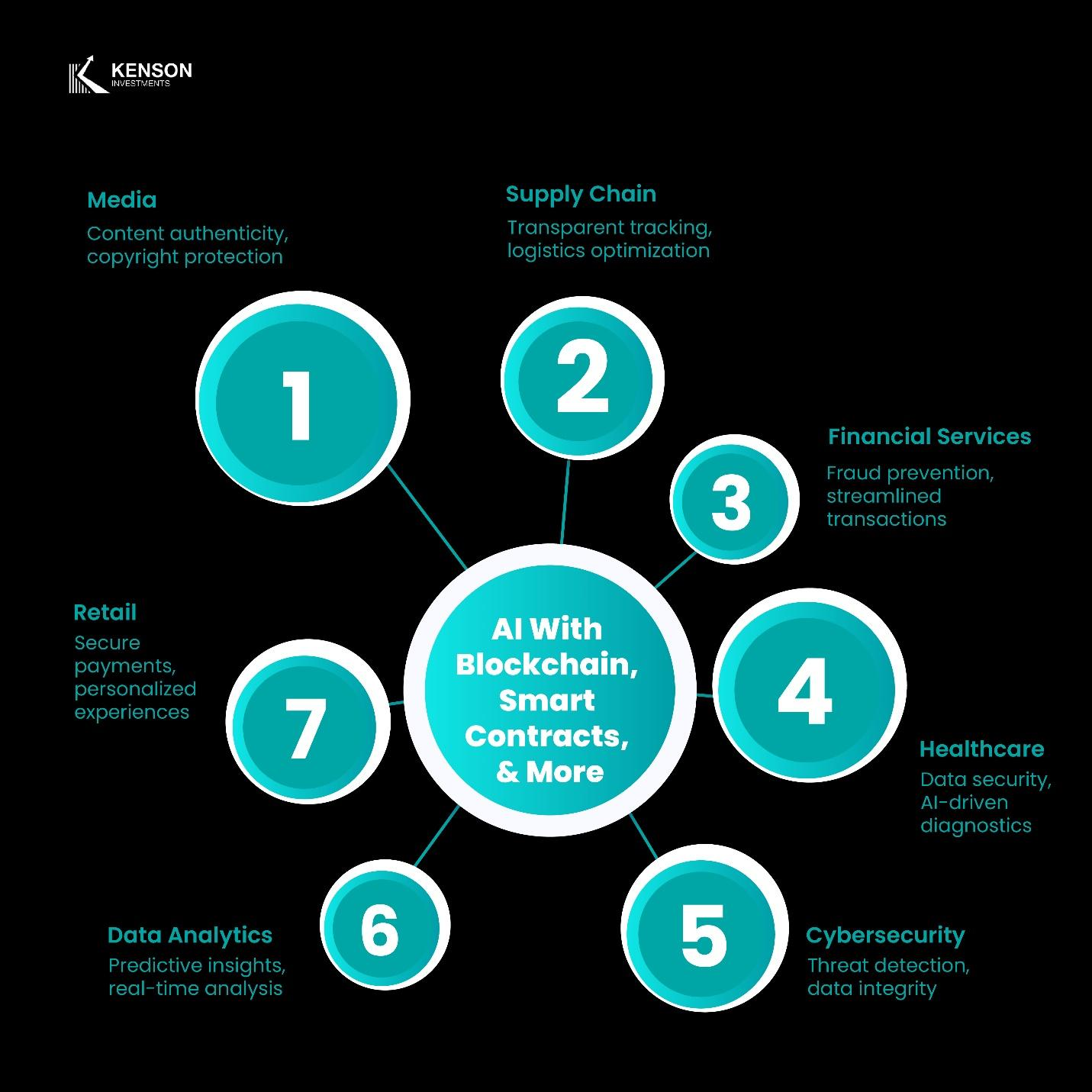
AI and blockchain are converging to create self-executing financial ecosystems that enhance efficiency, security, and compliance. The fusion of these technologies enables the development of predictive analytics, fraud detection, and automated regulatory compliance in institutional finance.
- AI for Predictive Analytics:Machine learning algorithms analyze on-chain and off-chain data to forecast market movements with increased accuracy.
- Smart Contract Execution:AI-enhanced smart contracts adjust investment strategies dynamically based on market conditions, ensuring optimal capital allocation.
- Fraud Prevention & Compliance:AI models detect anomalies in blockchain transactions, improving Anti-Money Laundering (AML) and Know Your Customer (KYC) processes.
📌 A BIS report highlighted that AI-enhanced smart contracts could reduce trade settlement times by 95%, eliminating inefficiencies in traditional financial infrastructure.
How AI Will Shape the Next Generation of Portfolio Management Consultants
As AI continues to evolve, the role of asset managers will shift from active decision-making to strategic oversight, with a focus on managing AI-driven models rather than individual investments.
- AI-Augmented Decision Making:Portfolio managers will leverage AI-generated insights to refine investment strategies rather than executing trades manually.
- Customizable AI Funds:Investors will have the ability to select AI-driven strategies tailored to their risk tolerance, financial goals, and market outlook.
- Human + AI Collaboration:Portfolio management consultants will act as “AI supervisors,” ensuring ethical AI use, managing model biases, and interpreting AI-driven insights within broader macroeconomic contexts.
Do You Know: A McKinsey report predicts that by 2030, AI will handle over 80% of investment decision-making processes in institutional finance, fundamentally transforming asset management.
While AI will not replace human portfolio management consultants entirely, its role in investment decision-making and risk management will continue to expand, redefining the financial landscape in the coming decade.
Investment Opportunities in AI-Driven Financial Markets
How Institutional Investors Can Leverage AI-Powered Hedge Funds
Institutional investors, including pension funds, sovereign wealth funds, and family offices, are increasingly turning to AI-powered hedge funds to enhance returns, optimize risk management, and gain a competitive advantage in global markets. AI-driven funds leverage deep learning, natural language processing (NLP), and reinforcement learning to process vast amounts of financial data in real time, identifying alpha-generating opportunities that human traders might overlook.
Advantages of AI-Powered Hedge Funds for Institutional Investors
🔹 Superior Alpha Generation: AI models analyze structured and unstructured data—including earnings reports, macroeconomic indicators, and alternative datasets such as satellite imagery and social media sentiment—to identify profitable trades.
🔹 Adaptive Market Strategies: Unlike traditional quantitative funds that rely on predefined models, AI-driven funds dynamically adjust trading strategies based on evolving market conditions.
🔹 Risk Mitigation and Liquidity Optimization: AI-powered funds use predictive analytics to detect market anomalies, preventing exposure to systemic risks and optimizing liquidity allocation across diverse asset classes.
🔹 Reduced Management Costs: AI-driven automation minimizes operational inefficiencies, reducing management fees compared to traditional hedge funds.
Key Sectors Where AI Funds Are Dominating
- Equities & Algorithmic Trading:AI-enhanced stock selection models use sentiment analysis and factor investing to outperform benchmarks.
- Commodities & FX:AI-driven funds leverage real-time macroeconomic data to optimize currency and commodity trading strategies.
- Crypto & Digital Assets:AI models process on-chain and off-chain data to predict price movements and manage portfolio volatility.
The Long-Term Outlook for AI-Driven Financial Strategies
The future of AI-driven finance will be defined by greater automation, enhanced predictive accuracy, and deeper integration with emerging technologies like blockchain and quantum computing. Institutional investors who embrace AI today will be better positioned to capitalize on these advancements.
Predictions for the Next Decade
AI-Driven Active Management Will Eclipse Passive Investing: As AI models become more sophisticated, active AI-powered funds will generate superior returns, challenging the dominance of passive index strategies.
Autonomous Investment Decision-Making: Reinforcement learning algorithms will evolve to execute trades without human intervention, enhancing speed and efficiency.
Integration with Decentralized Finance (DeFi): AI will power on-chain hedge funds and algorithmic asset management strategies in the DeFi ecosystem, providing institutional-grade liquidity solutions.
Regulatory Adaptation & Compliance: As AI-driven trading becomes mainstream, regulatory bodies like the SEC and ESMA will establish standardized frameworks for algorithmic accountability and risk transparency.
The Next Era of AI-Powered Investing
The rise of artificial intelligence in asset management is fundamentally reshaping global investment strategies. AI-powered funds are increasingly outperforming traditional portfolio managers, leveraging machine learning, alternative data sources, and predictive analytics to generate alpha. However, as AI-driven investing becomes mainstream, institutional and retail investors must navigate new challenges—including regulatory scrutiny, ethical concerns, and the risks associated with opaque AI decision-making.
What Investors Need to Know Before Betting on AI Funds
As artificial intelligence (AI) transforms the financial sector, AI-driven hedge funds and investment strategies are gaining significant traction. While these funds promise enhanced market analysis, predictive accuracy, and automated execution, investors must carefully evaluate the risks, potential rewards, and underlying mechanisms before allocating capital. Here’s what investors need to consider before committing to AI-powered funds.
AI’s Role in Investment Decisions
AI-driven funds employ machine learning (ML), natural language processing (NLP), and deep learning to analyze market data, identify trading patterns, and execute trades. Unlike traditional funds, which rely on human portfolio managers, AI-powered funds make real-time, data-driven decisions with minimal human intervention.
🔹 Quantitative vs. AI Funds – While quantitative funds use statistical models to make investment decisions, AI funds continuously adapt and learn from new data, improving predictive accuracy over time.
🔹 AI’s Edge in Market Analysis – AI models process vast amounts of structured (financial statements, price data) and unstructured (news sentiment, social media trends) data faster and more comprehensively than human analysts.
🔹 Algorithmic Execution & Risk Management – AI-powered funds dynamically adjust portfolios, hedging against downside risks and capitalizing on emerging trends more efficiently than traditional trading strategies.

Evaluating Performance Metrics Beyond Backtesting
Investors often look at historical performance and backtested results when assessing a fund, but AI-driven funds present unique challenges:
🔹 Overfitting Risks – AI models trained on historical data may perform well in simulations but struggle in real-world, evolving market conditions.
🔹 Live Performance vs. Backtesting – Investors should scrutinize live trading performance over extended periods rather than relying solely on backtested simulations.
🔹 Adaptive Learning Limitations – While AI continuously learns from new data, unexpected market shocks (e.g., black swan events) may expose weaknesses in algorithmic strategies.
The Regulatory and Ethical Landscape Moving Forward
As AI-driven investing becomes more prevalent, regulators worldwide are working to establish compliance frameworks to ensure market integrity and investor protection. The rapid evolution of AI-powered trading strategies presents both opportunities and challenges for financial institutions, regulators, and investors. While AI can enhance efficiency and reduce human biases in asset management, it also introduces new risks related to transparency, accountability, and systemic stability.
Global Regulatory Trends: SEC, MiFID II, and AI Governance
🔹 U.S. SEC Scrutiny: AI Transparency and Risk Disclosure
The Securities and Exchange Commission (SEC) has intensified its focus on AI-driven trading platforms, citing concerns over market stability, investor protection, and the potential for manipulation. Key areas of regulatory attention include:
- AI Model Explainability:The SEC is considering requiring AI-powered funds to disclose how their algorithms generate trading decisions, addressing concerns over the “black box” nature of machine learning models.
- Systemic Risk Monitoring:AI trading systems operate at speeds and complexities beyond human comprehension, raising fears of unintended consequences such as self-reinforcing feedback loops that could exacerbate market volatility.
- Investor Protection & Misleading AI Claims:The SEC is also investigating asset managers that market AI-powered funds without fully explaining the risks associated with algorithmic decision-making.
🔹 MiFID II & Algorithmic Trading Rules in Europe
The Markets in Financial Instruments Directive II (MiFID II), enforced by the European Securities and Markets Authority (ESMA), establishes some of the world’s strictest rules on algorithmic and high-frequency trading (HFT). With the rise of AI-driven trading, European regulators are focusing on:
- Pre-Trade Risk Controls:Ensuring AI models do not engage in manipulative trading behaviors such as spoofing (placing and canceling orders to create misleading market signals).
- Post-Trade Reporting Requirements:AI-powered hedge funds and trading firms must provide detailed records of their algorithmic strategies to ensure compliance with market fairness principles.
- AI Governance and Human Oversight:MiFID II mandates that firms using AI in trading must maintain a level of human intervention and accountability, preventing fully autonomous systems from making unchecked investment decisions.
AI Fairness Compliance: Addressing Algorithmic Biases
Beyond financial regulations, global authorities are working to establish AI ethics frameworks to prevent biased trading models from exacerbating inequalities in financial markets. These initiatives aim to:
- Prevent AI-Driven Market Discrimination:AI models trained on historical financial data may develop biases that unfairly favor or disadvantage certain asset classes, geographies, or investor profiles.
- Combat Model Overfitting & Unfair Trading Advantages:Regulators are exploring whether some hedge funds gain unfair competitive advantages by using proprietary AI models that exploit hidden market inefficiencies inaccessible to smaller investors.
- Ensure AI Explainability in Trading Decisions:Financial institutions are under pressure to adopt Explainable AI (XAI) techniques that allow regulators and investors to understand why AI models make specific trading decisions.
Ethical Considerations: The Future of AI-Driven Market Participation
As AI continues to reshape global finance, ethical concerns surrounding its use in asset management are becoming increasingly urgent. While AI-driven trading systems offer significant advantages, they also pose new risks related to market fairness, employment displacement, and ethical investment practices.
Market Manipulation Risks: Preventing AI-Driven Flash Crashes
One of the biggest ethical concerns is the potential for AI-driven market manipulation. Unlike traditional traders, AI models operate at speeds and complexities beyond human oversight, leading to:
Flash Crashes: AI models executing trades at high speeds can trigger unintended price swings, as seen in the 2010 Flash Crash, when algorithmic trading wiped out nearly $1 trillion in market value within minutes.
Predatory AI Strategies: Some AI-powered funds employ aggressive trading tactics, such as order anticipation, where AI detects large institutional trades and positions itself advantageously, potentially harming retail investors.
Collusion Risks in High-Frequency Trading (HFT): If multiple AI-driven funds develop similar strategies, they could unintentionally collude, amplifying price distortions or liquidity shortages.
Employment Displacement in Asset Management
The rise of AI in finance is also raising concerns about the future of human portfolio managers and financial analysts. As AI takes over key investment decision-making functions, industry shifts include:
Reduction in Traditional Fund Managers: AI-driven hedge funds are increasingly outperforming human traders, leading to job losses in portfolio management roles.
Growing Demand for AI Specialists in Finance: While AI is displacing traditional roles, it is also creating demand for quantitative analysts, AI ethicists, and financial data scientists.
Challenges in Human-AI Collaboration: Some firms are exploring hybrid AI-human investment teams, where AI models generate trade recommendations that human managers review and approve.
Bias & Fairness in AI Trading Models
AI models are only as good as the data they are trained on. If AI trading algorithms learn from biased datasets, they may reinforce discriminatory financial practices, such as:
Geographic Bias in Investment Decisions: AI models trained on historical stock market data may favor developed markets over emerging markets, limiting opportunities for investors in certain regions.
Sectoral Bias in Portfolio Allocation: AI-driven funds may overweight tech stocks due to historical outperformance, ignoring fundamental valuation shifts.
Algorithmic Discrimination in Loan & Credit Markets: AI models used in financial services must ensure they do not discriminate against certain demographic groups when assessing investment risks.
The Path Forward for AI Regulation in Financial Markets
The integration of AI in asset management is irreversible, and while it brings unprecedented efficiency and performance benefits, it also raises fundamental regulatory and ethical concerns. Moving forward, financial regulators, institutional investors, and AI developers must work together to establish:
✅ Stronger AI Governance Frameworks: Implementing standardized AI ethics codes to ensure responsible investment practices.
✅ Transparency & Explainability Standards: Mandating AI-powered funds to disclose their decision-making methodologies to investors and regulators.
✅ Risk Mitigation Strategies: Establishing circuit breakers and AI monitoring systems to prevent flash crashes and manipulative trading behaviors.
Ultimately, the success of AI in financial markets will depend on striking the right balance between innovation and regulation, ensuring AI-driven investing remains a force for financial stability rather than systemic risk.
Gain a Competitive Edge with AI-Driven Hedge Funds
The integration of machine learning and artificial intelligence is revolutionizing the investment landscape, enabling faster, more precise, and data-driven decision-making. AI-powered hedge funds leverage advanced algorithms, predictive analytics, and automated risk management to identify opportunities and navigate market complexities with greater efficiency than traditional strategies.
At Kenson Investments, we provide insights into the evolving role of AI in asset management, helping investors stay ahead in an increasingly sophisticated financial ecosystem. Discover how AI-driven funds are shaping the future of investing and position yourself at the forefront of innovation.
📌 Stay informed. Explore AI-powered investment opportunities with Kenson Investments today.



